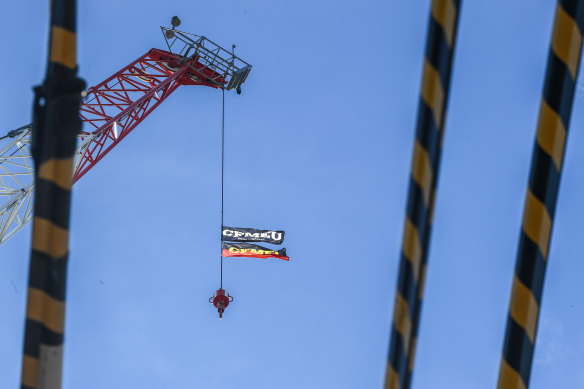- Exclusive
- Politics
- Federal
- Building Bad
This was published 4 months ago
Australians pay the price for CFMEU tactics, figures show
By David Crowe and Angus Thompson
Australians are paying the price for union tactics that add billions to the nation’s building costs and weaken productivity, as the federal government works on an urgent draft law to ensure it can overcome any attempts to block an overhaul of the CFMEU.
Labour productivity has fallen 18.1 per cent in the construction sector since 2014, far worse than in other parts of the economy, while the CFMEU is being blamed for a cost surge in the industry.

The federal government has vowed to clean up the CFMEU by appointing an external administrator.Credit: Peter Rae
The work on the draft law comes after the federal government said the Fair Work Commission would seek to impose an external administrator on the CFMEU after days of revelations from an investigation by The Age, The Sydney Morning Herald, The Australian Financial Review and 60 Minutes into the union’s ties to organised crime.
Employment Minister Tony Burke is preparing the new laws so they are ready to go next month if needed to impose the changes despite union objections.
Opposition Leader Peter Dutton has turned the dispute over the CFMEU into a political test over the cost of living, claiming the union has added 30 per cent to the cost of major projects.
The changes have the potential to influence costs across the economy because of the central role of the construction sector and the way major projects can be a burden on taxpayers and can impact households through housing and other costs.
Dutton’s cost claim is backed by Master Builders Australia and has some support from independent economists as well as the former head of the Australian Competition and Consumer Commission, Rod Sims.
“If somebody said the behaviour of the union was pushing up costs by 30 per cent, that would not surprise me,” Sims said.
“I don’t have any evidence to support the 30 per cent, but directionally it’s got to be right, and I suspect the quantum is not far out.”
Sims said construction affected everything from new supermarkets to office blocks and the cost increases were passed on to consumers.
“It also means there are projects that are not going ahead because they can only proceed if costs are below a certain level, and if the costs are pushed up because of activity by the CFMEU, then that means some projects don’t go ahead,” he said.
“It’s quite clear to me, from general observation over a long time, that that is exactly what’s happening.”
Master Builders Australia commissioned Queensland Economic Advocacy Solutions to analyse CFMEU wage deals that imposed sweeping conditions that could stop work, limit hours and put other restrictions on how work was done.
The analysis said an apartment project would be 3.5 per cent more expensive with a low application of the CFMEU provisions, 18.2 per cent more costly with a medium application and 33 per cent more expensive with a high application of the rules.
This meant a two-bedroom unit in Brisbane would cost $287,000 more than otherwise, it said. A three-bedroom unit would cost an extra $430,000, pushing its cost to $1.7 million.
CFMEU national secretary Zach Smith has not responded to requests for comment since the government’s announcement on Wednesday, and it is not yet known whether he will support the administration process.
Independent economist Harley Dale, who was the Housing Industry Association’s chief economist for 17 years, said CFMEU conduct at building sites had hampered productivity and added costs to consumers in both the residential and commercial sectors.
Labour costs were also a factor alongside issues such as planning delays, the cost of construction materials and the shortage of skilled workers, he said.
“There’s been a trend in the decline of labour productivity in construction since 2014 and it had a fresh low in 2023 after more than 10 years,” he said.
“I would argue that some of the obstructive behaviour on the part of the CFMEU has certainly been part of that.
“All of that’s got to feed through to the bottom-line pricing of these construction projects. Absolutely, it has to be passed on.”
The CFMEU has been contacted for comment.
Australian Bureau of Statistics figures show labour productivity has fallen 18.1 per cent in the construction sector since 2014.
By comparison, labour productivity fell 7.4 per cent in manufacturing and 3.9 per cent in transport over the same period, and increased by 19.3 per cent in professional, scientific and technical services, and by 31.5 per cent in agriculture, forestry and fishery.
Australian Constructors Association chief executive Jon Davies said the economy could be stronger if the labour slump was reversed in the building industry, highlighting an economic case for the government’s move against the CFMEU.
“If you look at productivity growth over 30 years, the gap between construction and other industries is about 33 per cent,” Davies said.
“Productivity has actually fallen in construction. If you apply that 33 per cent to the contribution of the construction industry to the economy, you get $56 billion. That’s the opportunity if we can close that gap.”
Burke said on Wednesday that if the appointment of an administrator was challenged in the Federal Court, he would introduce a bill in the parliament “to remove any barriers” to the leadership overhaul.
A government source said the process to draft the law had begun.
CFMEU Queensland secretary Michael Ravbar has vowed to oppose government intervention, while the NSW branch urged members to defend the union.
“To attack the CFMEU is to attack the very workers who build NSW, who pay tax to fund government projects and who vote politicians in and out of office,” the NSW branch said.
Cut through the noise of federal politics with news, views and expert analysis. Subscribers can sign up to our weekly Inside Politics newsletter here.